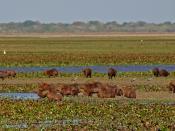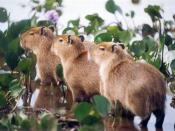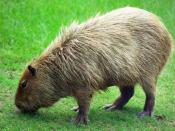Capybara The capybara is the largest rodent in the world. The capybara's name comes from the native people of South America. It means "master of the grass." The scientific name of the capybara is hydrochoerus hydrochaeris, which means "water pig" in Greek. Capybaras have been in existence since the Pleistocene epoch. Their ancient ancestors were rodents that lived about sixty million years ago. The average size of a capybara is four feet in length and two feet in height. This is about the size of a sheep. Capybaras usually weigh between sixty and one hundred and forty pounds. Many people think the capybara looks like a larger version of a guinea pig. All capybaras have large flat noses, webbed feet, short legs, and no tail. Their fur is very coarse and it is usually a reddish-brown color. Capybaras also have large incisor teeth that continuously grow. Capybaras must constantly gnaw and chew on wood and nuts to wear their teeth down.
To protect themselves from the hot sun, capybaras will often rest in nearby pools of water. They will also be found lying mud or in the shade.
Capybaras are found in South American countries such as Brazil and Venezuela. They are well adapted for living on land and in the water. Herds of capybaras, consisting of twenty or more capybaras, live on the grasslands and near riverbanks, or in swamps and marshes. Capybaras are herbivores whose main diet is water plants and grasses. Occasionally a capybara will also eat leaves, seeds and the bark of young trees. Because they are herbivores, they do not have any distinctive hunting habits.
Capybaras are shy creatures that don't interact with other animals on a frequent basis. They are intelligent but quiet and they rarely fight each other, or their...


